1981 Monaco Grand Prix race report

Ferrari's Gilles Villeneuve won his first race of the season on the streets of Monaco
Motorsport Images
A good race
Monte Carlo, May 31st
It will be a sad day when common-sense prevails and the Grand Prix is no longer held round the streets of Monte Carlo, when Formula One drivers no longer do the things that their union would not like them to do, like driving through a tunnel, charging up a steep hill with a blind brow and a fast corner at the top, plunging downhill to a hairpin bend with no escape road or run-off area, or bouncing over bumps which must surely shake their back-teeth, for that and much more comprises a lap-of the Monte Carlo circuit; always has done, and hopefully always will. Certainly some parts have changed over the years, but so have the cars and the speeds and the power-to-weight ratios; it is still street-racing in its purest form, like the long-gone events at Nice, Barcelona, Naples, Bari, Geneva, Genoa, Lausanne, San Remo, Angouleme, Bordeaux, Aix-Ies-Bains; La Baule and Sables d’Olonne. Thankfully, the world of Formula 2 still has the circuit at Pau and Chris Pook and the Long Beach Grand Prix Association have brought a touch of healthy madness into this boringly sane world with their street race in California, every bit as good as, or even better than, Monte Carlo. Anywhere else the suggestion of starting the proceedings a day earlier, and having Friday off, would be met with storms of protests from the “professionals” but in Monte Carlo it seems to be accepted by everyone. In a grubby paddock on a converted airfield or artificial autodrome everyone gets irritable and they “tick” about this and that, but on the harbour’s edge at Monte Carlo, all is sunshine and light; or at least it seems to be.
Once into the bay of the Principality of Monaco, there is no easy way out, retreating is hampered by the mountains, escape to the east is blocked by Ferrari and Alfa Romeo enthusiasts pouring in from Italy, the way west is hampered by hopeful Renault and Talbot enthusiasts queueing up to get in and in front of you is the Meditteranean. If you are affluent enough, and there are a lot of such people in Monaco, you can sail away in your boat or escape vertically in your helicopter. For normal people you are trapped in Monte Carlo and it is up to you to make the most of it, for motor racing enthusiasts it is a unique opportunity not to be missed, like the Le Mans 24 hour race or the Indianapolis 500 mile race. For anyone lucky enough to get an entry for the event there is more than enough to occupy their minds, for there is no opportunity to spend a couple of days “testing”, flogging round and round wearing your own personal groove into the circuit. At Monte Carlo the first official practice session starts at 10 a.m. on Thursday morning and that is the first opportunity for anyone to drive a racing car on the Monegasque circuit, unless you are a “rabbit”. With so many teams eager to take part in the “round-the-houses” race and with the tight little circuit being limited to a grid of twenty cars, some weeding-out had to be done. This was done in two stages, firstly by a pre-qualifying session for teams who did not score points in any 1980 races, which whittled thirty-two drivers down to twenty-six, and then by Thursday and Saturday afternoon qualifying which whittled the twenty-six down to the required twenty. The 76 lap race then whittled the twenty down to one winner!
Pre-qualifying took place at 8 a.m. on Thursday morning and the ten aspirants were instantly reduced to nine by the mysterious ways of Mr. Schmidt within his ATS team, when he withdrew the entry for Jan Lammers. This left Borgudd (ATS), Daly and Salazar (March), Gabbiani and Ghinzani (Osella), Henton and Warwick (Toleman-Hart), Surer (Ensign) and Tambay (Theodore) and from these the fastest four were allowed to join in the serious business. It didn’t need a crystal ball, or even the timing equipment, to select “the four lads most likely to” – Tambay, Surer, Ghinzani and Gabbiani were “in” so all was well with the first move in the latest round of Formula One.
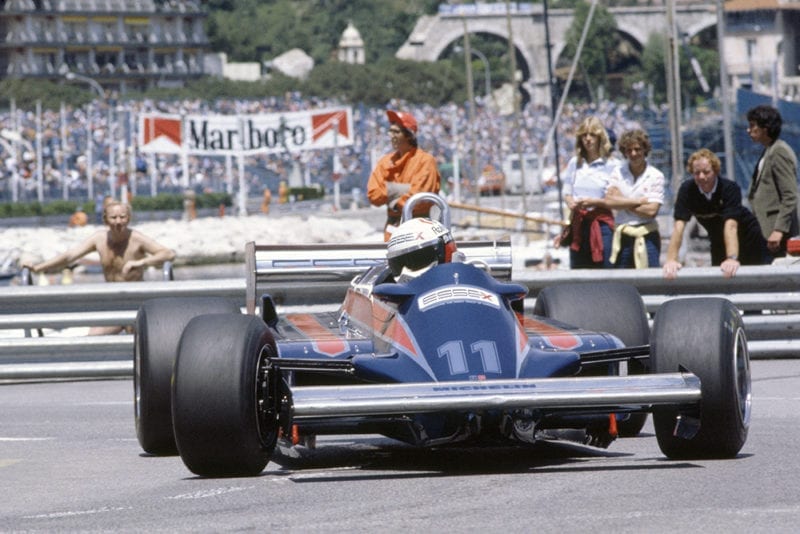
Elio de Angelis indicated improved performance for Lotus with 6th on the grid
Motorsport Images
For ninety minutes the select twenty-six thrashed round, settling the circuit into their ways, scuffing the kerbs, polishing the Armco, clearing the dust, rubberising the surface and generally getting everything ready for the serious one hour in the afternoon when every click of the Longines automatic timing apparatus was recorded and computerised for posterity, to seal everyone’s fate without question. Gone are the happy days of time-keeping disputes; when someone’s wife or girl-friend with a stop-watch challenged the old gentleman with the egg-timer.
For two years now the Longines radio transmitters fitted to Formula One cars activate the timing electronics to a thousandth of a second and no-one disputes the result. Not unexpectedly there were some alarms and excursions during the morning, Pironi damaged his Ferrari turbo (051) on the barrier at Rascasse, Villeneuve’s Ferrari turbo (052) was indecently fast, Piquet (Brabham BT49C/11) was really flying, Reutemann (Williams FW07C/12) was in his most impressive and menacing form, Jones was sorting out a brand new car (Williams FW07C/15) and Colin Chapman had produced two new cars, designated Type 87 in which the two “entirely sprung structures” of the Lotus 88 had become one. They were acceptable to everyone and what is more important, were well up with the front runners. Renault seemed to be in as much trouble with their new cars as they were in Belgium for Arnoux (RE31) suffered engine failure and Prost (RE32) would have looked quite good if only the Ferrari turbocharged cars had not been there. Talbot had one V12 Matra powered car near the front (Laffite) and one near the back (Jabouille) which must have had some bearing on the drivers, Tambay (Theodore) and Surer (Ensign) were making it very obvious that making them “pre-qualify” with the “rabbits” was a bit silly.
Qualifying
For the first officially timed hour, from 1 p.m. to 2 p.m. on Thursday, the overall scene was a bit dulled by the knowledge that the 6 centimetre ground-clearance rule was going to be measured on re-entry to the pits by a sophisticated light beam set up on a flat pad of concrete over which the cars had to pass slowly. There was no need to come to rest, but if the light beam registered “cheating” then the car was stopped and checked with a measuring stick. Every team of any substance was cheating blatantly while out on the circuit, with their automatic spring height adjusters reducing the regulation 6 cms. ground clearance to plus or minus zero, to seal the underside to the ground and gain adhesion by the “ground-effects” airflow under the car. At the moment this regulation 6 cms. cannot be checked at speed, but the Monaco “beam” was a step towards doing this. Most cars were fitted with an indicator in the cockpit to tell the driver if it was safe to return to the pits and be checked. Williams had a green light that came on when the car was high enough, Ferrari had wire-operated arrow-heads on a scale, one for each side of the car, the scale painted red and green; even the “whiter-than-white” Renault team were using hydraulics to raise and lower the cars and the sudden influx of wires, hydraulic pipes, air-lines, switches, oil unions, levers, and reservoirs has made today’s Formula One cockpit look like a mini Jumbo-jet. One just hopes there is enough time left for the driver to concentrate on his driving, but what is silly in that it is all in aid of cheating the rules, and if anything malfunctions a driver’s driving efforts are negated when he returns to the pits. The two biggest headaches in a mechanical vehicle (motorcycle, car, lorry, bus or aeroplane) are electrics and hydraulics.
In spite of all this nonsense, and a few times being scrubbed when drivers got caught by the light, it did not affect the overall scene, the fast ones were fast, some of the mid-field runners blossomed and the back-markers were the usual lot at the back, though on this occasion with the total limited to twenty-six and the qualifiers limited to twenty, even the last man on the grid could feel very pleased with himself. The real significance lay at the front of the field, with Piquet almost one whole second ahead of the next car, but it was this car that everyone should have been paying attention to, for it was red and powered by a turbo-charged 1 1/2-litre V6 engine, against the unsupercharged 3-litre engines of the others.
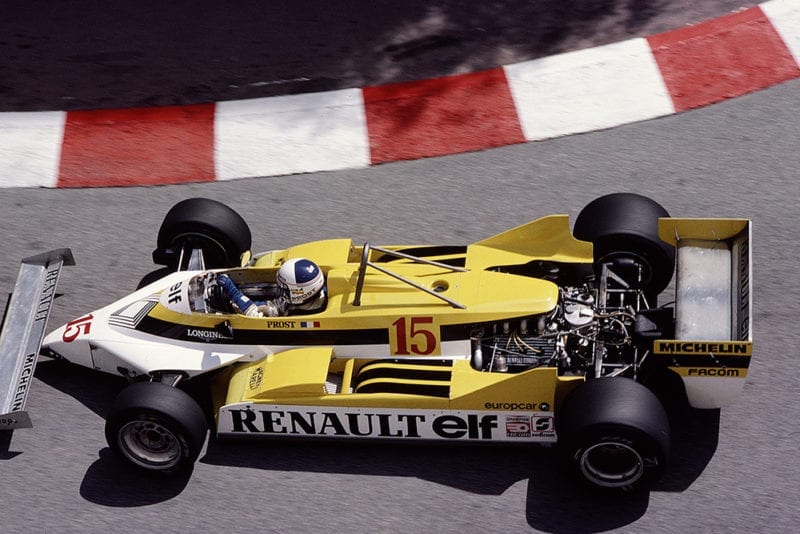
Alain Prost qualified 9th for Renault
© Motorsport Images
Needless to say it was driven by Gilles Villeneuve and was a Ferrari 126CK. He was all on his own up the front, for his team-mate Pironi was in the spare Ferrari and pranged it at the Massenet corner before he really got going. Two accidents to Pironi, second place to Villeneuve. You could call it “swings and roundabouts”, though Mauro Forghieri had other ideas. Alain Prost with the new RE32 turbo-Renault would have looked good in eighth place had Villeneuve and the Ferrari not been in second place, and poor Arnoux was nowhere as his new car had broken its engine in the morning and he had to use the old spare car. Another significant thing was that Team Lotus were back where they belong, the new Type 87 being totally legal as far as Chapman’s “friends” were concerned, and one of the cars was fourth fastest, not driven by de Angelis, but by Britain’s own Brummie, Nigel Mansell. While the young Italian was fiddling about and looking for ways to make the car help him go fast, and getting petulant if it didn’t, Mansell got stuck in and put all his effort into his driving. The result was Mansell fourth, de Angelis twelfth.
The reigning World Champion Alan Jones may not be setting the pace this year, but he is never far away and the car with number one on it was in a good solid third place. Reutemann would have been up there with him had he not been caught cheating by the light beam. At this point in the four-day Monaco gamble Serra (Fittipaldi), Gabbiani (Osella), Alboreto (Tyrrell), Rosberg (Fittipaldi) and Stohr (Arrows) were on the elimination list, together with Ghinzani (Osella) who did not practise at all. While serious-minded people like Keith Duckworth and Brian Hart were looking closely at the turbo-charged Ferrari engine, others were waving their arms and mouthing-off about Piquet having done his time in an illegal car. Certainly he was in BT49C/9, the spare car, most of the time, but the “shouters” were saying it was under the regulation weight of 585 kilogrammes. At the end of a race, on worn tyres, worn brake pads and low oil level a Brabham has been seen to weigh 585.01 kilogrammes so it would not need much imagination to produce a car that was under the weight limit, but it would be easier and more effective to use a 3.3-litre Cosworth V8 or better still, to be such a good team that Keith Duckworth gives you a specially prepared, totalty legal, DFV that gives 520 b.h.p., or more likely for Monaco, 480 b.h.p. with an enormous torque range.
Anyone who is interested in what is going to happen, rather than what has happened, was pondering on why the turbo-Ferrari engine has no throttle-lag, why its mixture control is impeccable, why its reliability is already proven, and why it was in second place on a circuit that the “know-alls” tell us is impossible for a turbo-charged engine. Keith Duckworth went away murmuring “Hmm, I see … ” and no doubt Brian Hart was thinking to himself. Meanwhile, people like Ken Tyrrell, Teddy Meyer and even Colin Chapman, were blowing a lot of hot air and Mauro Forghieri was probably thinking “they should blow that into their engines”. Renault were not happy at all.
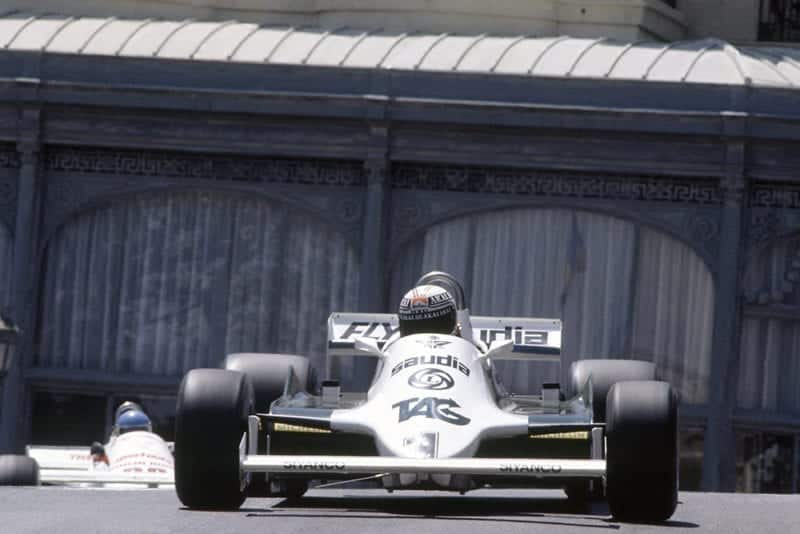
Alan Jones put his Williams 7th on the grid
© Motorsport Images
Friday was a day of rest for the Formula One world, though there was plenty to do. You could work on your cars, have a meeting, throw a party, go away and visit friends, stir things up with the newspaper people or sit in your car in a traffic jam; what you could not do was lie in the sun; for it disappeared behind heavy cloud. Saturday morning everyone was back on the job bright and early, ready for the start of the test-session at 10 a.m. and the weather was still cool and cloudy, just right for tyres, engines and road conditions. Everyone thrashed round trying this and that, Ferrari had sent off for a fourth car to replace one of Pironi’s wrecks and Brabham had a fourth one which Rebaque used in place of his own car which he had bent the day before. Arnoux was back in his new Renault and everything was pretty orderly. Some years ago the chances of completing a full lap without let or hindrance was about one in ten, but this figure is more like one in fifteen today, with cars getting bigger and faster and more exacting to drive on the limit.
Add to that the possibility of being caught cheating and losing your lap times, and it’s a wonder a grid-pattern ever appeared. No sooner had the final hour of timed practice got under way than Arnoux hit the barriers by the swimming pool and yellow flags, cement dust and marshals removing the wreckage put a stop to any serious laps. This was Arnoux’s RE30 so he was forced to go back to the RE20 Renault. Pironi was in equal trouble, with an engine failure in the morning and a brush with a guard rail in the fourth turbo Ferrari (049) in the afternoon, giving him a flat rear tyre and damaged suspension. Meanwhile Villeneuve was on terrific form (he always is!) and made fastest time of the afternoon, only 7/100ths of a second off Piquet’s pole-position time. Piquet was content to cruise round testing things rather than improve on his Thursday time, as no-one had looked like getting near to it.
This confirmed in the minds of many that he had used a demon-lightweight “qualifying car” to record his 1 min. 25.710 sec., no-one seemed to want to give him credit for his driving ability, and when Villeneuve did 1 min. 25.788 sec. by dint of a fantastic bit of do-or-die overtaking arriving at the Tabac corner his time was put down to 570-600-700 horsepower. One other driver got into the 1 min. 25 sec. bracket and that was Nigel Mansell in the Lotus 87/1 with 1 min. 25.815 sec., the result of a lot of hard work, skill and determination and devotion to the business of being a racing driver. There are still those who bleat about the driver not being important any more (especially a certain TV commentator!) but there are as many who are loath to admit that Ferrari has built a good car or that the Lotus 87 is a good car. The mere thought that Chapman has produced another winner made some people rush off to their drawing boards.
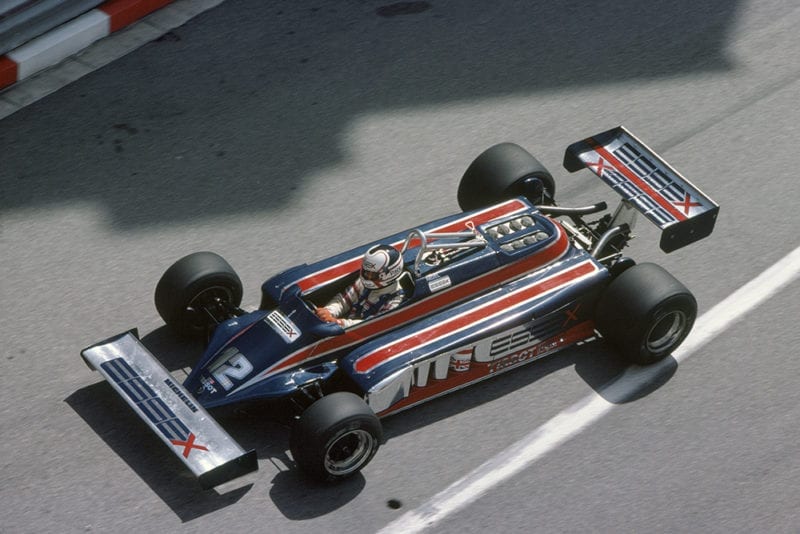
Nigel Mansell qualified 3rd for Lotus
© Motorsport Images
The whole business of juggling with all the variables on a Formula One car, getting everything right at the right time, having an unhampered run for one and a half minutes and not being caught cheating, made the whole business of the grid position seem like a game of Russian Roulette. With the exception of Pironi, whose troubles were known, the grid order of the twenty qualifiers was surprisingly reasonable in spite of all the hazards. Rosberg, Jabouille, Rebaque, Serra, Ghinzani and Gabbiani were left out, in that order. Piquet was on pole-position with his Brabham, with Villeneuve (Ferrari), Mansell (Lotus), Reutemann (Williams), Patrese (Arrows), de Angelis (Lotus), Jones (Williams) and Laffite (Talbot-Matra) all eager to get by. The original thirty-two had been whittled down to twenty-six and they had now been whittled down to twenty and the 76 laps were going to whittle them down to one, for there is only a winner at a Grand Prix, there are no sub-divisions or categories in Formula One, nor are there any degrees of winning. The man who finishes first wins the race, subject of course to 456 rules and sub-sections, nineteen protests, Tribunals, Courts of Appeal, lawyers, solicitors, judges and so on and so forth.
Race
Sunday was a superb holiday-brochure day, with blue sea, blue sky, bright warm sunshine, a large but not overpacked crowd, and everything was set for a good race. The whole organisation had gone perfectly, everyone was happy, or as happy as they could allow themselves to be, and the twenty cars were being readied for the 3.30 p.m. start. The normal routine is for the Prince and Princess of Monaco to lunch at the Palace with their favoured entourage, then descend the slopes from the Palace in a suitable car, make a lap of the circuit to declare the track ready for racing, take their seats in the Royal box (and stuff Royal cotton wool in their ears, to endure the awful two hour racket of these awful racing people) and then present the winner with his prize, or at least with his cup if not with his cheque. This year none of it happened, for the Prince and Princess were away in America with more important things to attend to, among them the graduation from College of their son. The racing world planned to manage all right without them, arranging for Maurice Trintignant (winner at Monaco in 1955 and 1958) to inaugurate the circuit in a Grand Prix Bugatti.
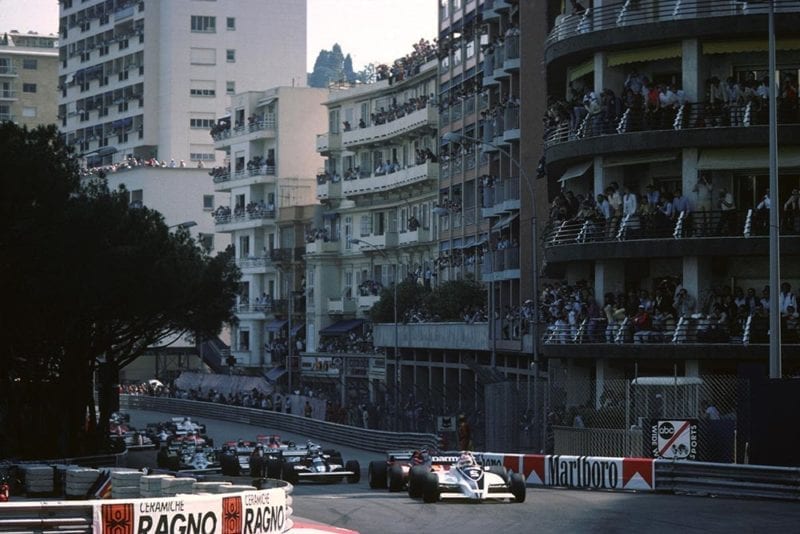
Nelson Piquet leads at the start
Motorsport Images
When everything is set for the race, that part of the town in the middle of the circuit is sealed off in its entirety, so when a fire broke out in the kitchens of the fancy new plastic hotel built where the old station used to be, and above the newly constructed seafront tunnel, there was a fair degree of panic. Add to that two motorcycle policemen having a head-on collision and the fire-brigade being hampered at getting to the fire, it is no wonder that proceedings were held up. The fire was brought under control at the expense of a lot of water, most of which ran though the floors and through the roof of the tunnel which forms part of the circuit. The organisation deserve every credit for keeping the whole affair under control and though the great god television was held up for an hour there was no panic and no acrimony because concise and clear statements were given out (in four languages) so that everyone knew what was going to happen.
The tunnel was declared a “no-passing” zone, indicated by a yellow flag at the entrance and green beyond the exit and if the water dried up during the race the flags would be removed. This was not to say you could not drive through the water if you wanted to, nor did you have to go slowly, it was simply a “no-overtaking” ban. From the pits the cars were allowed two warm-up laps in place of the regulation one lap, and as 4.30 p.m. approached Nelson Piquet led a very orderly twenty cars round on the parade lap and back to the starting grid. The green light shone and they were away into the cramped Saint Devote chicane; Piquet was first out and up the hill to the Casino lik’e a rocket, waiting for no-one, but the twenty car field was reduced to eighteen as the dust settled and the McLaren-MP4 of de Cesaris and the Alfa Romeo V12 of Andretti were seen lying derelict by the roadside. Everyone blamed everyone else, naturally, and Prost (Renault) and Surer (Ensign) were lucky to still be going all right, though the Swiss took the Ensign out into the pits for a new wheel and a quick check-over.
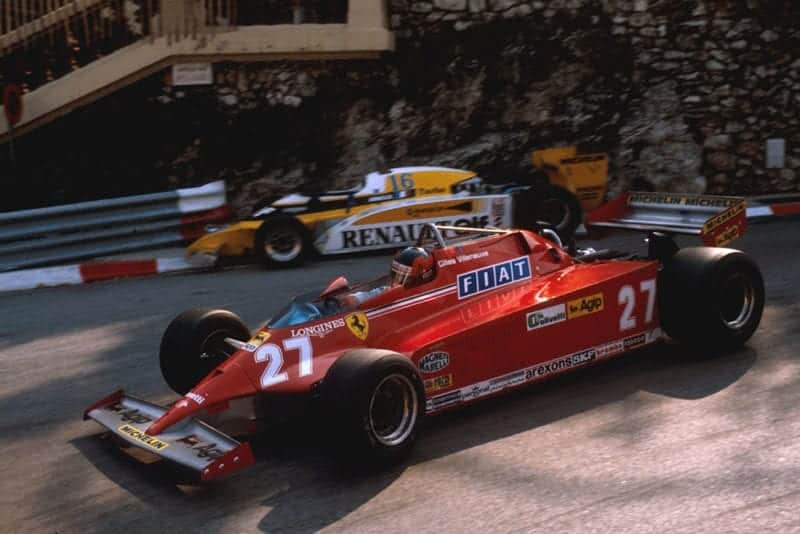
Gilles Villeneuve takes on Loews Hairpin
Motorsport Images
Piquet was running away from everyone, with Villeneuve in second place followed by Mansell doing his utmost to fend off the likes of Reutemann, Jones, Patrese, de Angelis and Laffite, and he was doing it well. By lap 7 the pattern of the opening phase of this race of corners and gearchanges was settled, Piquet in the leading Brabham was well away, Villeneuve was a strong second, bearing in mind that he could burn up his tyres or cook his brakes too easily if he exaggerated, and third was the worthy Mansell but behind him Reutemann, Jones, Patrese and de Angelis were getting a bit agitated. Then came a French trio in the order Laffite, Prost and Arnoux, then a lonesome Watson in the MP4 McLaren, an equally lonely Tambay in the Theodore car followed by Cheever in the blue Tyrrell. Bringing up the rear were Stohr in the second Arrows, Giacomelli in the remaining Alfa Romeo, Pironi in the second Ferrari and Alboreto keeping up with them comfortably. A long way back, after his pit stop, and about to be lapped by Piquet was Surer in the Ensign, now running strongly. The “ten green bottles” syndrome was still being enacted for Stohr went slowly up the hill to the Casino, the Cosworth engine in his Arrows car popping and banging.
Unintentionally, Surer held up Villeneuve through a particularly twisty part of the circuit and the following bunch closed up on the Ferrari, while Piquet got further ahead. On lap 14 Mansell got a bit sideways and Reutemann bent the nose of his Williams on the back of the Lotus 87 and by the time he stopped at the pits, had a new nose fitted and rejoined the race he was down to fifteenth place. No-one was waiting for anyone. Mansell stopped to change a rear wheel, did one more lap and went back to the pits, where a rear suspension rocker arm was found broken, so that was that. Villeneuve’s brakes were beginning to feel a bit less than one hundred per cent efficient, so he did not press any harder than was necessary to maintain his pace.
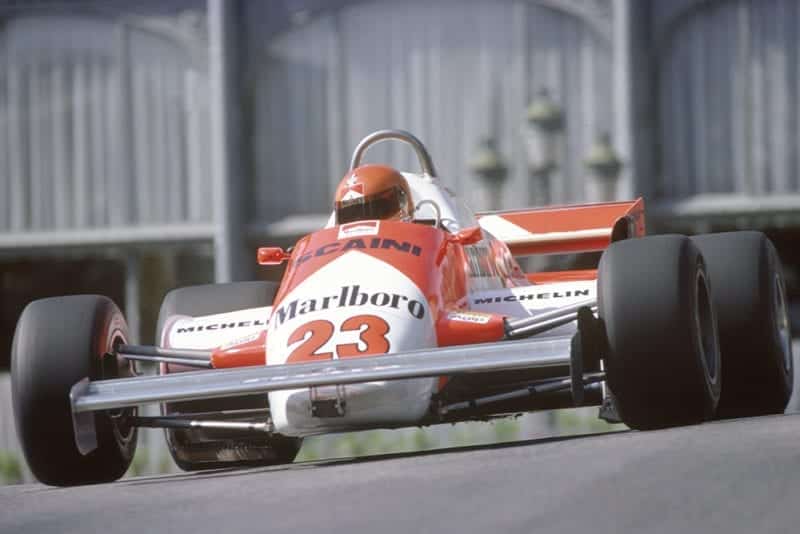
Bruno Giacomelli crashed out on lap 50
© Motorsport Images
Jones on the other hand was piling on the coal, with Mansell and Reutemann gone from in front of him and on lap 20 he dived past the Ferrari, took second place and set his sights on the leading Brabham. It was “Jonesyboy” at his hardest and best and little by little the gap closed, while behind him Patrese got by Villeneuve, the Ferrari driver content to run as fast as he could without stressing the car or indulging in heroics against faster rivals at this early stage in the race. Every now and again the moving chicane in the shape of Stohr’s white and orange Arrows A3 would re-appear, going awfully slowly, but it wasn’t his fault for the engine would not run properly no matter what the mechanics did. In fifth place was de Angelis with the second Lotus 87 but he was not making much headway, though he was safely ahead of the froggie-trio who had been joined by Watson. At the back of the field Reutemann was carving his way through and among them was a very dispirited Pironi who was having a totally demoralising weekend, while the happy Alboreto was still keeping up nicely.
It began to look as if a situation of stalemate was developing between Piquet and Jones, with a gap of around seven seconds, which was just as well for since their argy-bargy in Zolder, which ended up with Piquet in the rough stuff there had been no love lost between the two of them. During practice various trouble-making journalists had transmitted dire threats from one to the other; but they had never spoken face-to-face. The Brazilian Piquet is a very determined young man and the Australian is . . . well, an Australian, and they are not cast or forged, they are carved from the solid. Piquet and Jones were now about to lap the tail-enders, starting with Alboreto and then having Giacomelli, Pironi, Cheever and Tambay to circumnavigate, and this saw Jones at his best. They got clear of the traffic by lap 38 and on lap 39 the Williams was right under the tail of the Brabham and you could imagine Jones saying “What are you going to do to me?” and Piquet looking in his mirrors and thinking “If that Australian thug tries anything I’ll have him off into the barriers”. The situation was really tense and for three breathtaking laps the Williams was really leaning on the Brabham, but it was deadlock. Meanwhile Villeneuve was comfortably in third place and wondering if they were going to give him first place on a plate.
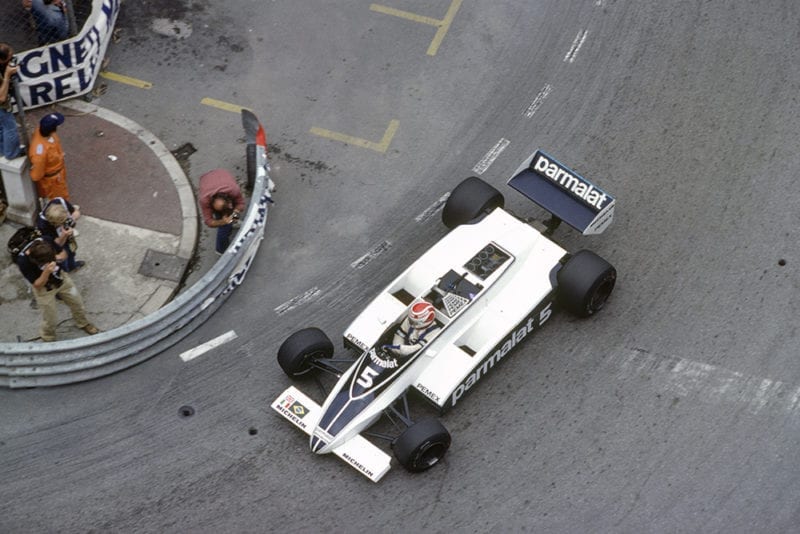
Nelson Piquet spun out after leading much of the race
© Motorsport Images
Quite a while before this situation arose, de Angelis went up the hill to the Casino with his engine making a horrid noise; at the old station hairpin he dropped a lot of oil and clanked his way on trying to get back to the pits. Arnoux arrived on the oil and slid gracefully into the barriers and out of the race, so now Laffite was fourth and Watson fifth, though neither of them had ever passed anyone! Reutemann’s climb back up the field was halted when first and second gears broke up in his gearbox and the Williams long period of reliability was interrupted. At half-distance only Piquet, Jones, Villeneuve, Laffite and Watson remained on the same lap, Tambay, Pironi, Giacomelli, Alboreto, Cheever (who had had a spin) and Surer were all well behind. As Jones was putting the pressure on Piquet there was a shattering bang from the engine of the renault and Prost and another “green bottle” had gone.
On lap 46 Jones goofed slightly down on the harbour front and Piquet got away a little, but not for long as the Williams was up behind the Brabham three laps later only to ease back slightly, deliberately this time, for there were still 25 laps to go. Down at the back of the field Alboreto was ahead of Giacomelli, to the joy of one and the chagrin of the other, but on lap 51 they fell over each other at Saint Devote and that was that. Tambay was in trouble and going slowly without his full complement of gears and as Piquet hurtled along the harbour front on lap 54 he arrived at the Tabac corner at just the wrong moment. He misjudged overtaking the Theodore and slid into the barriers with a sickening “crunch” and as Jones went by into the lead he must have smiled to himself. Watson had been bravely hanging on to Laffite’s Talbot-Matra and would have inherited fourth place had his engine not blown up, so now we only had seven cars left and nobody was going to catch anyone so we could have stopped the race there and then with the perfectly satisfactory result of Jones in first place, Villeneuve second, Laffite third, Pironi fourth, Cheever fifth, Surer sixth and Tambay seventh, but there was still a long way to go; 20 laps in fact.
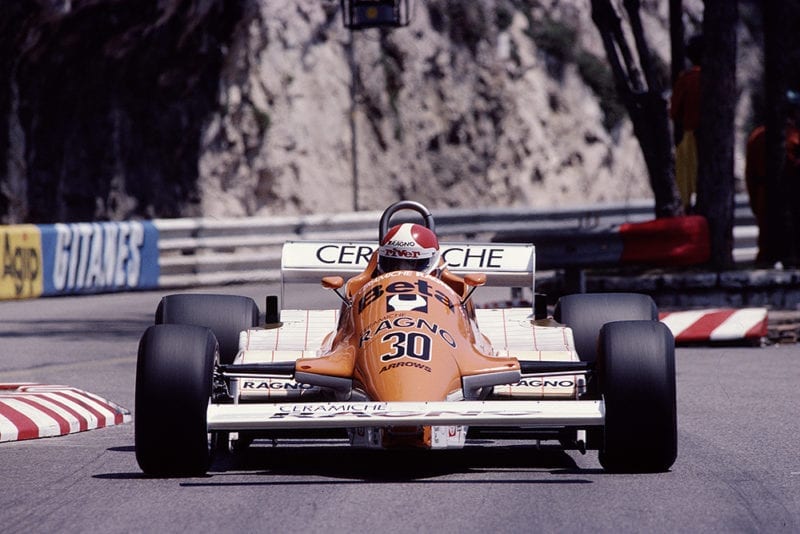
Siegfried Stohr failed to get beyond 14 laps after a fuel line failure
© Motorsport Images
It was too far for Jones for his engine began to stutter and in the cockpit a red light was shining. This meant that the fuel pressure generated by the mechanical pump had dropped below 90 p.s.i., and the injection system needs 120 p.s.i. to make it work properly. Switching on the electric pump, normally only used for starting, did not help, so with more than enough time in hand over Villeneuve’s Ferrari, Jones signalled to his pit that he was stopping next time round for more petrol, just in case the trouble was low level in the tank or the system not picking up the last few gallons. Completely unknown to Villeneuve, the Williams dived into the pits, a 2 1/2 gallon container of petrol was emptied into the tank and Jones was back on the track before Villeneuve arrived. When he went past his pit and they signalled the much reduced gap he assumed Jones had had a spin somewhere, but when next time round the gap was smaller he realised the Williams was in trouble. In trouble it was, for the stuttering was getting worse and the red light was still shining, indicating that the fuel pressure was still below 90 p.s.i. There were eight laps still to run and Villeneuve used all the Ferrari would give, making his own fastest lap of the race on lap 71 (though a lot slower than Jones’ fastest lap recorded earlier in the race) and passing the stricken Williams in front of the pits as they completed lap 72. Monte Carlo erupted. Hooters and sirens echoed round the harbour, flags waved, hats flew, tears ran down the cheeks of all the Ferrari fans, marshals waved flags in all directions and the myriad of Villeneuve fans prayed fervently that the turbo-charged V6 Ferrari engine would hold together for four more laps. Of course, it did and there was no need to ask who was a popular winner. A lucky win, yes, profiting from Jones’ bad luck but when the good luck is being handed out you’ve got to be there, and ready, it’s no good being a lap behind and cruising along dispiritedly. Jonesey must have thought once again “Goddam, that guy never gives up.”
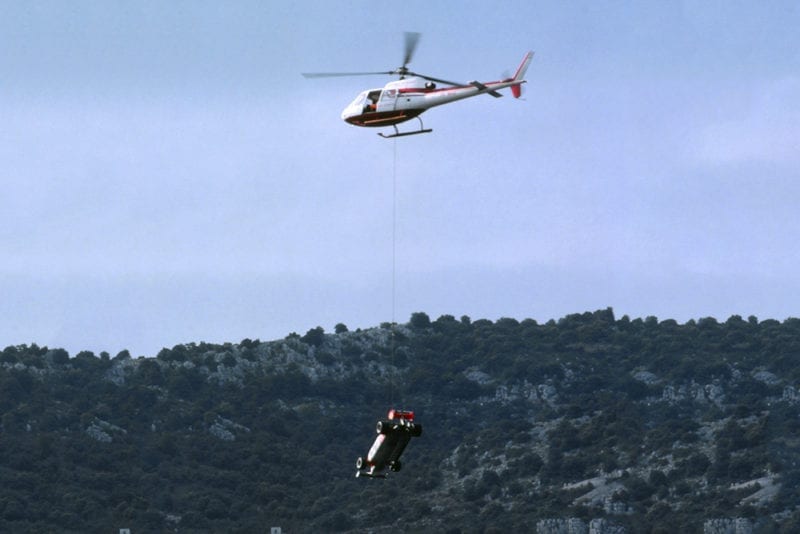
The Alfa Romeo 179C of Mario Andretti is lifted off the circuit by helicopter
© Motorsport Images
On a more sober note, the turbo-charged 1 1/2-litre Ferrari scored its first victory only eight months after it first ran in public and even more significant is that it did it on the tight and twisty Monaco circuit. With Pironi in fourth place with the second turbo Ferrari it meant that two cars started and two cars finished for the third race in succession, Imola, Zolder and Monaco. During ‘practice’ it was announced that Villeneuve and Pironi had signed with Ferrari for 1982 and 1983, and some people had wondered why. In Maranello, Enzo Ferrari must have been smiling quietly to himseIf. If you follow the political hoo-hah you could think that Formula One is sick. Once that green light comes on over the starting grid the sickness disappears and you can be sure that Brabham and Williams are not going to sit back and watch Ferrari progress, while Mansell’s brief performance would indicate that Lotus are back in the game. For teams like Ensign, ATS, March, Fittipaldi and Tyrrell there seems little hope of survival, let alone keeping up with the big-boys who are now really slogging away at each other.
By the time this is being read we will have had another Grand Prix (the Spanish) and the French GP will be imminent, so it may prove to be a lot of rubbish, but time and patience will tell. – D.S.J.
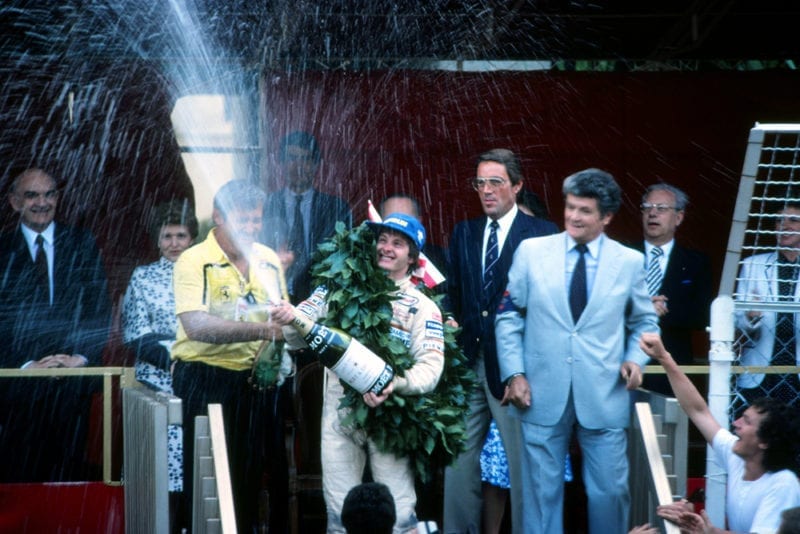
Race winner Gilles Villeneuve sprays the victory champagne on the podium
© Motorsport Images
